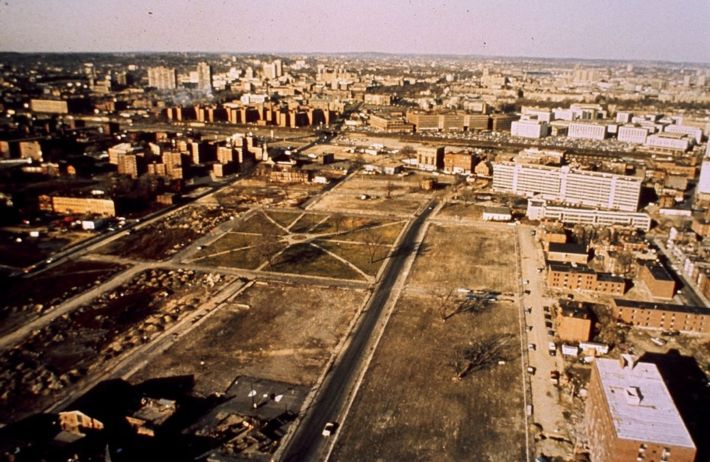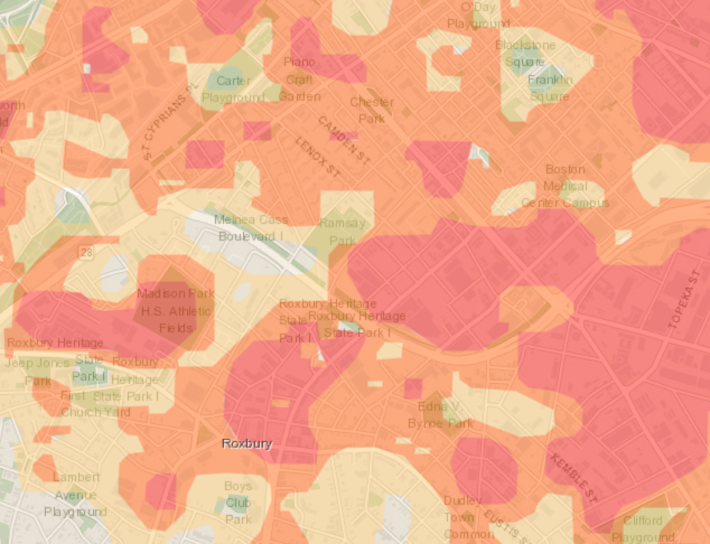Tree preservation advocates in Roxbury are finally finding sympathetic listeners in Boston's City Hall this summer: a MassDOT project that will remake Melnea Cass Boulevard could be revised so that more of the Boulevard's mature trees will be preserved during the multi-year duration of construction.
Melnea Cass Boulevard, which extends from Columbus Avenue to Massachusetts Avenue in Roxbury, ranks among the city’s most dangerous road segments. The City of Boston and MassDOT have been planning for a complete reconstruction of Melnea Cass for most of the past decade, and by 2018, the agencies had agreed on a design that would install protected bicycle lanes, raised crosswalks at intersections, improved bus stops, and landscaped medians.
But for many Roxbury residents, the idea of bulldozers destroying their trees to make way for a road project recalls the traumas of the city's urban renewal and Inner Belt highway plans, which razed hundreds of buildings in the same neighborhood.

"Thousands of families will be affected by this environmental racism," said Tomiqua Williams, a member of the Friends of Melnea Cass, at a Sept. 14 press event. "The city moving full steam ahead is a vehicle of the colonial mentality for Roxbury, everyone else thinking they know what's best for us Roxbury residents."
Concern over the trees intensified during the summer's record-breaking heat waves. David Meshoulam, the executive director of Speak for the Trees Boston and another member of the Friends of Melnea Cass, argues that mature trees are especially important to mitigating Roxbury's "urban heat island" effects.

"You can feel the difference, especially in summer, when you stand under a tree. It’s not just shade – that’s part of it – but trees also cool by evapotranspiration, cycling water through their system... that process of water evaporating into gas provides air conditioning benefits," says Meshoulam. "And then there are also the intangible benefits around mental and community health: trees provide a sense of rest, and taking trees away can be traumatic."
Project documents clearly indicate that preserving trees has been a widely-held goal of the community from the early stages of the project's design process: a 2018 filing for state environmental permits states that the design had been "refined through communication and coordination with local community members... (to limit) impacts to existing mature trees."
The same filing states that 48 trees were slated for removal in the project – a figure that had been reduced from over 200 tree removals in the earliest stages of design.
But that number crept upward again in subsequent design iterations, each of which got fewer opportunities for public scrutiny.
By June 2019, the "100 percent" design blueprints, which would ultimately be used as a template for the construction project, called for the complete removal of 121 mature trees, in addition to root trimming that would impact hundreds of other trees in the corridor.
Earlier this year, MassDOT authorized a $26 million contract with the Newport Construction Corporation of Nashua, NH to execute that design. The choice of that contractor also raised eyebrows among tree advocates: in 2017, Newport allegedly cut down several mature trees along Beacon Street without notifying abutters.
The Friends group may have gotten a boost this summer, when Dr. Karilyn Crockett, who chronicled Roxbury's activism against the Inner Belt in her book People Before Highways, joined Mayor Walsh's cabinet as the city's new Chief of Equity.
According to Boston officials, Crockett started collaborating with other city staff over the summer to reevaluate the project with a focus on its impacts to historically underserved communities in Roxbury.
At the end of August, the Boston Cyclists Union, which had been involved in the earlier design process and supportive of the project's proposed bike and pedestrian safety improvements, joined calls for the city to put the project on pause. And at a September 14th press conference, the Friends of Melnea Cass welcomed support from Boston City Council President Kim Janey, Councilor Michelle Wu, and State Senator Sonia Chang-Díaz.
Because the project is already under contract between MassDOT and Newport, the City of Boston has limited influence. But city officials say that they are working with MassDOT to pursue possible "change orders" to the agreement.
"MassDOT is aware we are reviewing the project to see if we could save additional trees," wrote a Boston Transportation Department (BTD) official in an email last week.
Change orders to a project that's already under contract can be expensive, but they're not unusual. Peter Furth, a Professor of Civil Engineering at nearby Northeastern University, observes that minor changes to the project's protected bikeways and sidewalks could preserve more trees at relatively low cost.
"A change like moving the entire roadway over, or changing the drainage – that can be expensive and hard to do (once a project is already under contract)," said Furth in a phone conversation with Streetsblog last week. "But making the bike path a little bit narrower in some locations to save a row of trees – changes that wouldn't actually cost any more to construct – those could be relatively easy."
BTD also asserts that the current contract with Newport has "strong language" for tree protection and care throughout the duration of the project, and that contract change orders for additional tree protections are also under consideration.






